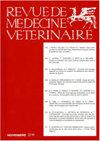Contribuciones de las ciencias veterinarias a la Colombia rural
Q2 Veterinary
引用次数: 0
Abstract
Higher education has a disciplinary structure. For this reason, it is relevant to analyze the contribution of a field of knowledge to a sector or social field. This is the purpose of this work, which seeks to understand the contribution of veterinary sciences (VS) to Colombian rurality and to provide feedback for educators and researchers. The study evaluated contribution to knowledge generation and the visibility of the relations between VS and rurality in the national context. 91 VS-oriented research groups were identified, 90 of which, with 1553 members, showed contribution to Colombian rurality. These groups are concentrated in the capitals of the Andean and north-west central cultural regions. 2219 rural publications were registered between 2006 and 2016. The article was the most frequently used resource (91%) in national and Spanish media. The main themes were: production (48.2%), animal health (19.1%), environment (13.2%), and epidemiology (7.5%). On the other hand, internet activity exposed the limited public interest in rural veterinary medicine, although upward trends were observed for “veterinary” and “veterinary, rural” results, which reflects a weak relationship between VS practice and Colombian rurality. This is reinforced by the lack of links and actions taken by the public agricultural sector to strengthen the education and provision of veterinary services. The results evidence the contribution of VS in Colombia and provide useful information for the planning of future rural strategies.兽医科学对哥伦比亚农村的贡献
高等教育具有学科结构。因此,分析一个知识领域对一个部门或社会领域的贡献是有意义的。这是这项工作的目的,旨在了解兽医科学(VS)对哥伦比亚农村的贡献,并为教育工作者和研究人员提供反馈。该研究评估了在国家背景下对知识产生的贡献以及VS与乡村性之间关系的可见性。确定了91个面向志愿服务的研究小组,其中90个有1553名成员,对哥伦比亚农村作出了贡献。这些群体集中在安第斯山脉和西北中部文化区的首都。2006 - 2016年共登记农村出版物2219种。这篇文章是国内和西班牙媒体中使用频率最高的资源(91%)。主要主题为:生产(48.2%)、动物卫生(19.1%)、环境(13.2%)和流行病学(7.5%)。另一方面,互联网活动暴露了公众对农村兽医的有限兴趣,尽管“兽医”和“兽医,农村”结果呈上升趋势,这反映了VS实践与哥伦比亚农村之间的弱关系。公共农业部门为加强兽医服务的教育和提供而缺乏联系和采取的行动,加剧了这种情况。结果证明了VS在哥伦比亚的贡献,并为未来农村战略的规划提供了有用的信息。
本文章由计算机程序翻译,如有差异,请以英文原文为准。
求助全文
约1分钟内获得全文
求助全文
来源期刊

Revue De Medecine Veterinaire
农林科学-兽医学
CiteScore
1.30
自引率
0.00%
发文量
0
审稿时长
18-36 weeks
期刊介绍:
The Revue de Médecine Vétérinaire publishes four kinds of text:
1) Scientific reviews on subjects related to veterinary and comparative medicine. Suggested length: 10 to 30 typed pages.
2) Original reports on fundamental or applied research. Suggested length: 10 to 15 typed pages.
3) Continuous education articles, that should be easily understandable by non-specialists. Suggested length: 10 to 15 typed pages.
4) Clinical reports. Suggested length: 5 to 15 typed pages.
The publication can be done in French language or English language.
For an article written in English by not english native speakers authors, the manuscript must be subjected by attesting that it was read again by an anglophone scientist or a scientific translator.
The authors must certify that the manuscript was not published or subjected for publication to another review.
The manuscript must be accompanied by a sheet signed by all the joint authors indicating their agreement for the tender of the manuscript.
The publication is free but a financial participation could be required for the photographs color. An estimate will be sent to collect the agreement of the authors.
 求助内容:
求助内容: 应助结果提醒方式:
应助结果提醒方式:


